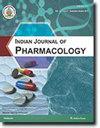Pharmacological benefits of durva swaras (Cynodon dactylon L. Pers.) administration in APAP-induced liver injury model of mice - Assessment by metabolic and inflammatory markers.
IF 1.5
4区 医学
Q4 PHARMACOLOGY & PHARMACY
引用次数: 0
Abstract
OBJECTIVE Liver derangement underlies the development of metabolic syndrome in perimenopause. Previously, we have observed that durva swaras (DS) improved metabolic-associated fatty liver disease (MAFLD) and abnormal liver enzymes (aspartate aminotransferase and alanine aminotransferase) along with other complications of menopause in ovariectomized rats. We aimed to decipher the hepatoprotective mechanisms of DS in acetaminophen (APAP)-induced liver injury model, which is analogous to the pathophysiology of MAFLD. MATERIALS AND METHODS Male Swiss albino mice were distributed into three groups at random. Group I (Control) was administered with vehicle (distilled water) for 7 days. Group II (APAP) received vehicle for the first 6 days and APAP (350 mg/kg - single dose) on the 7th day. Group III (APAP + D) received test compound DS (quality complied) at a dose of 133 mg/kg for 6 days and APAP (350 mg/kg - single dose) on the 7th day. Subsequently, blood and liver tissues were subjected to biochemical, ultrastructural, and gene expression analysis. RESULTS DS pretreatment protected the liver from APAP-induced disruption of sinusoids and necrosis. DS prevented the elevation of liver enzymes - AST and ALT induced by APAP. Importantly, DS inhibited the APAP-elicited increase in messenger ribonucleic acid levels of hepatic nuclear factor-kappa beta (NF-κB) and pro-inflammatory cytokines, namely interleukin-1 beta, interleukin 6, and tumor necrosis factor-alpha. Moreover, DS activated gene expression of nuclear factor erythroid 2-related factor 2 and liver-X-receptor-alpha (LXR-α) to combat the liver damage. CONCLUSION DS hinders APAP-induced liver damage by activating LXR-α and inhibiting the NF-κB-associated pro-inflammatory cytokine gene expression. These observations confirm the protective role of DS in metabolic dysfunction-associated liver conditions.服用杜仲(Cynodon dactylon L. Pers.)对 APAP 诱导的小鼠肝损伤模型的药理作用--通过代谢和炎症标记物进行评估。
目的肝脏失调是围绝经期代谢综合征发病的基础。以前,我们曾观察到杜尔瓦斯瓦拉(DS)能改善卵巢切除大鼠的代谢相关性脂肪肝(MAFLD)、肝酶异常(天冬氨酸氨基转移酶和丙氨酸氨基转移酶)以及更年期的其他并发症。我们的目的是破译 DS 在对乙酰氨基酚(APAP)诱导的肝损伤模型(类似于 MAFLD 的病理生理学)中的保肝机制。I 组(对照组)使用药物(蒸馏水)7 天。第二组(APAP)前 6 天服用载体,第 7 天服用 APAP(单剂量 350 毫克/千克)。第 III 组(APAP + D)连续 6 天服用剂量为 133 毫克/千克的试验化合物 DS(质量合格),第 7 天服用 APAP(350 毫克/千克 - 单剂量)。随后,对血液和肝组织进行生化、超微结构和基因表达分析。DS 阻止了 APAP 引起的肝酶--谷草转氨酶和谷丙转氨酶的升高。重要的是,DS 抑制了 APAP 引起的肝脏核因子-卡巴 beta(NF-κB)信使核糖核酸水平和促炎细胞因子(即白细胞介素-1 beta、白细胞介素 6 和肿瘤坏死因子-α)的增加。此外,DS 还能激活核因子红细胞 2 相关因子 2 和肝 X 受体-α(LXR-α)的基因表达,从而对抗肝损伤。这些观察结果证实了 DS 在代谢功能障碍相关肝病中的保护作用。
本文章由计算机程序翻译,如有差异,请以英文原文为准。
求助全文
约1分钟内获得全文
求助全文
来源期刊
CiteScore
4.00
自引率
4.20%
发文量
53
审稿时长
4-8 weeks
期刊介绍:
Indian Journal of Pharmacology accepts, in English, review articles, articles for educational forum, original research articles (full length and short communications), letter to editor, case reports and interesting fillers. Articles concerning all aspects of pharmacology will be considered. Articles of general interest (e.g. methods, therapeutics, medical education, interesting websites, new drug information and commentary on a recent topic) are also welcome.

 求助内容:
求助内容: 应助结果提醒方式:
应助结果提醒方式:


